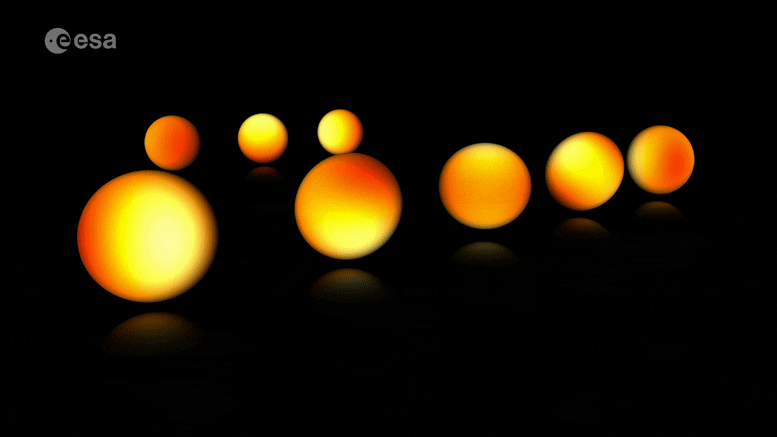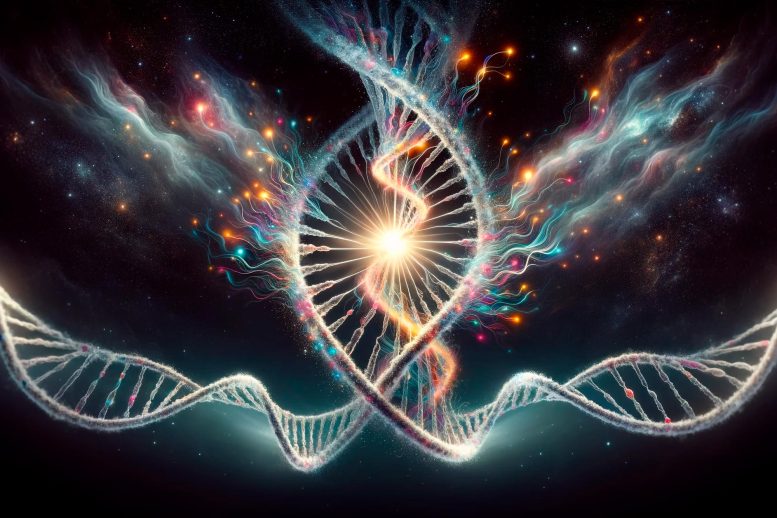
Μία από τις εκπληκτικές ανακαλύψεις που προέκυψαν από την απελευθέρωση δεδομένων Gaia 3 είναι ότι η Gaia είναι σε θέση να ανιχνεύει αστρικούς σεισμούς – μικροσκοπικές κινήσεις στην επιφάνεια ενός άστρου – που αλλάζουν τα σχήματα των αστεριών, κάτι για το οποίο δεν κατασκευάστηκε αρχικά το αστεροσκοπείο. Πίστωση: ESA/Gaia/DPAC, CC BY-SA 3.0 IGO
Η Gaia είναι η αποστολή του Ευρωπαϊκού Οργανισμού Διαστήματος (ESA) να δημιουργήσει έναν ακριβή τρισδιάστατο χάρτη με περισσότερα από ένα δισεκατομμύριο αστέρια[{” attribute=””>Milky Way galaxy and beyond. Although it launched all the way back in 2013, it is still working to accurately map the the motions, luminosity, temperature and composition of the stars in our galaxy.
Along the way it has made numerous discoveries, such as detecting a shake in the Milky Way, the observation of almost 500 explosions in galaxy cores, crystallization in white dwarfs, and discovering a billion-year-old river of stars. It also revealed the total weight of the Milky Way, a direct measurement of the galactic bar in the Milky Way, mysterious fossil spiral arms in the Milky Way, and a new member of the Milky Way family.
Today marks the data of the third data release from Gaia. The first data release was on September 14, 2016, followed by the second data release on April 25, 2018. On December 3, 2020, they did an early third data release with detailed data on more than 1.8 billion stars. All this data is helping to reveal the origin, structure, and evolutionary history of our galaxy.

This image shows four sky maps made with the new ESA Gaia data released on June 13, 2022. Credit: © ESA/Gaia/DPAC; CC BY-SA 3.0 IGO
Today (June 13, 2022), ESA’s Gaia mission releases its new treasure trove of data about our home galaxy. Astronomers describe strange ‘starquakes’, stellar DNA, asymmetric motions, and other fascinating insights in this most detailed Milky Way survey to date.
Gaia is ESA’s mission to create the most accurate and complete multi-dimensional map of the Milky Way. This allows astronomers to reconstruct our home galaxy’s structure and past evolution over billions of years, and to better understand the lifecycle of stars and our place in the Universe.
Τι νέο υπάρχει στην έκδοση δεδομένων 3;
Η έκδοση δεδομένων Gaia 3 περιέχει νέες και βελτιωμένες λεπτομέρειες για σχεδόν δύο δισεκατομμύρια αστέρια στον γαλαξία μας. Ο κατάλογος περιλαμβάνει νέες πληροφορίες συμπεριλαμβανομένων χημικές συνθέσειςαστρικές θερμοκρασίες, χρώματα, μάζες, ηλικίες και η ταχύτητα με την οποία τα αστέρια κινούνται προς ή μακριά από εμάς (ακτινική ταχύτητα). Πολλές από αυτές τις πληροφορίες αποκαλύφθηκαν από το πρόσφατα δημοσιευμένο Φασματοσκοπία Δεδομένα, μια τεχνολογία στην οποία το αστρικό φως χωρίζεται στα συστατικά του χρώματα (όπως το ουράνιο τόξο). Τα δεδομένα περιλαμβάνουν επίσης ειδικά υποσύνολα αστεριών, όπως αυτά που αλλάζουν τη φωτεινότητα με την πάροδο του χρόνου.
Επίσης νέος σε αυτό το σύνολο δεδομένων είναι ο μεγαλύτερος μέχρι σήμερα κατάλογος δυαδικών αστεριών, χιλιάδων αντικειμένων του Ηλιακού Συστήματος όπως αστεροειδείς και πλανητικά φεγγάρια και εκατομμύρια γαλαξίες και κβάζαρ έξω από τον Γαλαξία μας.
σεισμούς
Μία από τις πιο εκπληκτικές ανακαλύψεις που προκύπτουν από τα νέα δεδομένα είναι ότι η Γαία είναι σε θέση να ανιχνεύει αστρικούς σεισμούς – μικροσκοπικές κινήσεις στην επιφάνεια ενός άστρου – που αλλάζουν τα σχήματα των αστεριών, κάτι για το οποίο δεν κατασκευάστηκε αρχικά το αστεροσκοπείο.
Προηγουμένως, η Γαία είχε ήδη βρει ακτινικές ταλαντώσεις που προκαλούν τα αστέρια να διογκώνονται περιοδικά και να συστέλλονται, διατηρώντας παράλληλα το σφαιρικό τους σχήμα. Αλλά ο Gaya έχει τώρα ανιχνεύσει και άλλους κραδασμούς που μοιάζουν πολύ με τσουνάμι μεγάλης κλίμακας. Αυτές οι μη ακτινικές ταλαντώσεις αλλάζουν το παγκόσμιο σχήμα του άστρου και επομένως είναι δύσκολο να ανιχνευθούν.
Η Γαία έχει βρει ισχυρούς μη ακτινωτούς σεισμούς σε χιλιάδες αστέρια. Η Γαία ανίχνευσε επίσης τέτοιες δονήσεις σε αστέρια που σπάνια είχαν δει στο παρελθόν. Αυτά τα αστέρια δεν πρέπει να έχουν κανέναν σεισμό σύμφωνα με την τρέχουσα θεωρία, ενώ η Γαία τους εντόπισε στην επιφάνειά τους.
“Οι αστερίες μας διδάσκουν πολλά για τα αστέρια, ιδιαίτερα για την εσωτερική τους λειτουργία. Η Γαία ανοίγει ένα χρυσωρυχείο για τεράστια αστρική επιστήμη”, λέει η Connie Aerts του KU Leuven στο Βέλγιο, μέλος της συνεργασίας Gaia.
αστρικό DNA
Το υλικό από το οποίο είναι φτιαγμένα τα αστέρια μπορεί να μας πει για το πού γεννήθηκαν και το επόμενο ταξίδι τους, και επομένως για την ιστορία του Γαλαξία. Με την απελευθέρωση δεδομένων σήμερα, η Gaia αποκαλύπτει τον μεγαλύτερο χημικό χάρτη του γαλαξία σε συνδυασμό με τρισδιάστατες κινήσεις, από την ηλιακή μας γειτονιά έως τους μικρότερους γαλαξίες γύρω μας.
Μερικά αστέρια περιέχουν περισσότερα «βαρέα μέταλλα» από άλλα. κατά τη διάρκεια της[{” attribute=””>Big Bang, only light elements were formed (hydrogen and helium). All other heavier elements – called metals by astronomers – are built inside stars. When stars die, they release these metals into the gas and dust between the stars called the interstellar medium, out of which new stars form. Active star formation and death will lead to an environment that is richer in metals. Therefore, a star’s chemical composition is a bit like its DNA, giving us crucial information about its origin.

This image shows an artistic impression of the Milky Way, and on top of that an overlay showing the location and densities of a young star sample from Gaia’s data release 3 (in yellow-green). The “you are here” sign points towards the Sun. Credit: © ESA/Gaia/DPAC; CC BY-SA 3.0 IGO
With Gaia, we see that some stars in our galaxy are made of primordial material, while others like our Sun are made of matter enriched by previous generations of stars. Stars that are closer to the center and plane of our galaxy are richer in metals than stars at larger distances. Gaia also identified stars that originally came from different galaxies than our own, based on their chemical composition.
“Our galaxy is a beautiful melting pot of stars,” says Alejandra Recio-Blanco of the Observatoire de la Côte d’Azur in France, who is a member of the Gaia collaboration.
“This diversity is extremely important, because it tells us the story of our galaxy’s formation. It reveals the processes of migration within our galaxy and accretion from external galaxies. It also clearly shows that our Sun, and we, all belong to an ever-changing system, formed thanks to the assembly of stars and gas of different origins.”

This image shows the orbits of the more than 150,000 asteroids in Gaia’s data release 3, from the inner parts of the Solar System to the Trojan asteroids at the distance of Jupiter, with different color codes. The yellow circle at the center represents the Sun. Blue represents the inner part of the Solar System, where the Near Earth Asteroids, Mars crossers, and terrestrial planets are. The Main Belt, between Mars and Jupiter, is green. Jupiter trojans are red. Credit: © ESA/Gaia/DPAC; CC BY-SA 3.0 IGO, Acknowledgements: P. Tanga (Observatoire de la Côte d’Azur)
Binary stars, asteroids, quasars, and more
Other papers that are published today reflect the breadth and depth of Gaia’s discovery potential. A new binary star catalog presents the mass and evolution of more than 800 thousand binary systems, while a new asteroid survey comprising 156 thousand rocky bodies is digging deeper into the origin of our Solar System. Gaia is also revealing information about 10 million variable stars, mysterious macro-molecules between stars, as well as quasars and galaxies beyond our own cosmic neighborhood.

The position of each asteroid at 12:00 CEST on June 13, 2022, is plotted. Each asteroid is a segment representing its motion over 10 days. Inner bodies move faster around the Sun (yellow circle at the center). Blue represents the inner part of the Solar System, where the Near Earth Asteroids, Mars crossers, and terrestrial planets are. The Main Belt, between Mars and Jupiter, is green. The two orange ‘clouds’ correspond to the Trojan asteroids of Jupiter. Credit: © ESA/Gaia/DPAC; CC BY-SA 3.0 IGO, Acknowledgements: P. Tanga (Observatoire de la Côte d’Azur)
“Unlike other missions that target specific objects, Gaia is a survey mission. This means that while surveying the entire sky with billions of stars multiple times, Gaia is bound to make discoveries that other more dedicated missions would miss. This is one of its strengths, and we can’t wait for the astronomy community to dive into our new data to find out even more about our galaxy and its surroundings than we could’ve imagined,” says Timo Prusti, Project Scientist for Gaia at ESA.

“Ερασιτέχνης διοργανωτής. Εξαιρετικά ταπεινός web maven. Ειδικός κοινωνικών μέσων Wannabe. Δημιουργός. Thinker.”

